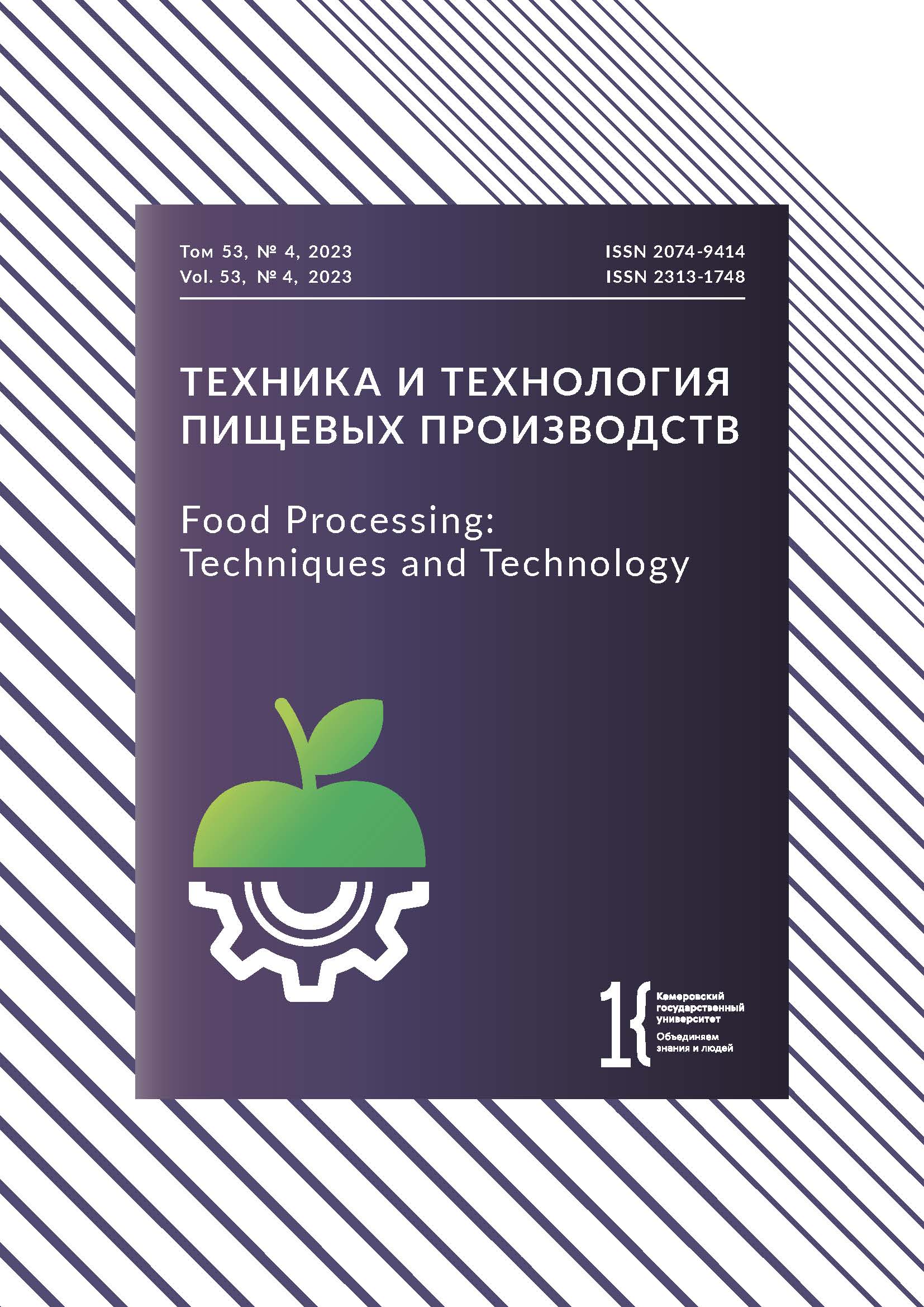Джакарта, Индонезия
Джакарта, Индонезия
Томаты (Solanum lycopersicum L.) являются важной сельскохозяйственной культурой. При переработке томатов образуются побочные продукты (кожица, мякоть, семена, отходы), которые выбрасываются производителями. Чтобы снизить потери, томатные выжимки используют для приготовления томатного кетчупа. Качество готового томатного кетчупа должно соответствовать требуемым стандартам, особенно физико-химическим и органолептическим характеристикам продукта. Цель работы – изучить влияние кукурузного крахмала на физико-химические, микробиологические и органолептические свойства томатного кетчупа, приготовленного из томатных отходов, и оценить потребительскую привлекательность готового продукта. Кетчуп готовили из томатных выжимок. Для загущения соуса добавляли кукурузный крахмал в концентрациях 1, 4 и 7 %. Соус варили при температуре 90 °С в течение 15 мин и горячим разливали в стерильные стеклянные банки. Анализ физических (цвет, вязкость, общий сухой остаток), химических (pH, титруемая кислотность, содержание влаги), микробиологических (общее количество бактерий, плесени и дрожжей) и органолептических свойств проводили по общепринятым методикам. Результаты исследования показали, что кукурузный крахмал влияет на цветовые характеристики томатного соуса. Добавление более 4 % кукурузного крахмала позволило повысить вязкость и общий сухой остаток (р < 0,05). Введение кукурузного крахмала в рецептуру позволило снизить количество воды и кислотность, а также повысило pH томатного соуса. Микробиологический анализ не выявил роста бактерий, плесени или дрожжей в тестируемых образцах. Томатный соус с 1 % кукурузного крахмала получил самую высокую оценку по органолептическим показателям. Более высокие концентрации кукурузного крахмала негативно влияли на консистенцию продукта. Правильно подобранная рецептура позволяет использовать побочные продукты переработки томатов в качестве сырья для производства экологичных продуктов с добавленной стоимостью и хорошими органолептическими характеристиками. Однако для повышения эффективности производства кетчупа из томатных выжимок в промышленного условиях требуются дополнительные исследования.
Solanum lycopersicum L., кетчуп, томатные отходы, кукурузный крахмал, качество, безопасность
1. Kumar M, Tomar M, Bhuyan DJ, Punia S, Grasso S, Sá AGA, et al. Tomato (Solanum lycopersicum L.) seed: A review on bioactives and biomedical activities. Biomedicine and Pharmacotherapy. 2021;142. https://doi.org/10.1016/j.biopha.2021.112018
2. Liu W, Liu K, Chen D, Zhang Z, Li B, El-Mogy MM, et al. Solanum lycopersicum, a model plant for the studies in developmental biology, stress biology and food science. Foods. 2022;11(16). https://doi.org/10.3390/foods11162402
3. Bot F, Calligaris S, Cortella G, Nocera F, Peressini D, Anese M. Effect of high pressure homogenization and high power ultrasound on some physical properties of tomato juices with different concentration levels. Journal of Food Engineering. 2017;213:10-17. https://doi.org/10.1016/j.jfoodeng.2017.04.027
4. Dai T, McClements DJ, Niu X, Guo X, Sun J, He X, et al. Whole tomato juice produced by a novel industrial-scale microfluidizer: Effect on physical properties and in vitro lycopene bioaccessibility. Food Research International. 2022;159. https://doi.org/10.1016/j.foodres.2022.111608
5. Khan UM, Sevindik M, Zarrabi A, Nami M, Ozdemir B, Kaplan DN, et al. Lycopene: Food sources, biological activities, and human health benefits. Oxidative Medicine and Cellular Longevity. 2021;2021. https://doi.org/10.1155/2021/2713511
6. Li N, Wu X, Zhuang W, Xia L, Chen Y, Wu C, et al. Tomato and lycopene and multiple health outcomes: Umbrella review. Food Chemistry. 2021;343. https://doi.org/10.1016/j.foodchem.2020.128396
7. Zhang W, Yu Y, Xie F, Gu X, Wu J, Wang Z. High pressure homogenization versus ultrasound treatment of tomato juice: Effects on stability and in vitro bioaccessibility of carotenoids. LWT. 2019;116. https://doi.org/10.1016/j.lwt.2019.108597
8. Mannino F, Pallio G, Altavilla D, Squadrito F, Vermiglio G, Bitto A, et al. Atherosclerosis plaque reduction by lycopene is mediated by increased energy expenditure through AMPK and PPARα in ApoE KO mice fed with a high fat diet. Biomolecules. 2022;12(7). https://doi.org/10.3390/biom12070973
9. Cámara M, Fernández-Ruiz V, Sánchez-Mata M-C, Cámara RM, Domínguez L, Sesso HD. Scientific evidence of the beneficial effects of tomato products on cardiovascular disease and platelet aggregation. Frontier in Nutrition. 2022;9. https://doi.org/10.3389/fnut.2022.849841
10. Puah B-P, Jalil J, Attiq A, Kamisah Y. New insights into molecular mechanism behind anti-cancer activities of lycopene. Molecules. 2021;26(13). https://doi.org/10.3390/molecules26133888
11. Méndez-Carmona JY, Ascacio-Valdes JA, Alvarez-Perez OB, Hernández-Almanza AY, Ramírez-Guzman N, Sepúlveda L, et al. Tomato waste as a bioresource for lycopene extraction using emerging technologies. Food Bioscience. 2022;49. https://doi.org/10.1016/j.fbio.2022.101966
12. Trombino S, Cassano R, Procopio D, Di Gioia ML, Barone E. Valorization of tomato waste as a source of carotenoids. Molecules. 2021;26(16). https://doi.org/10.3390/molecules26165062
13. Sibomana MS, Workneh TS, Audain K. A review of postharvest handling and losses in the fresh tomato supply chain: A focus on Sub-Saharan Africa. Food Security. 2016;8:389-404. https://doi.org/10.1007/s12571-016-0562-1
14. Santiago-Ramos R, Silva CLM, Ramos IN. Modelling and optimization of the processing of a healthy snack bar made of grape and tomato pomaces. Foods. 2022;11(17). https://doi.org/10.3390/foods11172676
15. Solaberrieta I, Mellinas AC, Espagnol J, Hamzaoui M, Jiménez A, Garrigós MC. Valorization of tomato seed by-products as a source of fatty acids and bioactive compounds by using advanced extraction techniques. Foods. 2022;11(16). https://doi.org/10.3390/foods11162408
16. Oboulbiga EB, Parkouda C, Savadogo B, Guissou AWDB, Traore K, Traore AS, et al. Changes in physicochemical properties and bioactive compounds of tomato pulp submitted to different processing techniques. African Journal of Food Science. 2020;14(10):330-335. https://doi.org/10.5897/AJFS2020.1998
17. Silva YPA, Borba BC, Pereira VA, Reis MG, Caliari M, Brooks MS-L, et al. Characterization of tomato processing by-product for use as a potential functional food ingredient: Nutritional composition, antioxidant activity and bioactive compounds. International Journal of Food Sciences and Nutrition. 2019;70(2):150-160. https://doi.org/10.1080/09637486.2018.1489530
18. Crops and livestock products [Internet]. [cited 2023 Jan 10]. Available from: https://www.fao.org/faostat/en/#data/QCL
19. Laranjeira T, Costa A, Faria-Silva C, Ribeiro D, de Oliveira JMPF, Simões S, et al. Sustainable valorization of tomato by-products to obtain bioactive compounds: Their potential in inflammation and cancer management. Molecules. 2022;27(5). https://doi.org/10.3390%2Fmolecules27051701
20. Torbica A, Belović M, Mastilović J, Kevrešan Ž, Pestorić M, Škrobot D, et al. Nutritional, rheological, and sensory evaluation of tomato ketchup with increased content of natural fibres made from fresh tomato pomace. Food and Bioproducts Processing. 2016;98:299-309. https://doi.org/10.1016/j.fbp.2016.02.007
21. Belović M, Torbica A, Pajić-Lijaković I, Tomić J, Lončarević I, Petrović J. Tomato pomace powder as a raw material for ketchup production. Food Bioscience. 2018;26:193-199. https://doi.org/10.1016/j.fbio.2018.10.013
22. Al-Muhtaseb AH, Al-Harahsheh M, Hararah M, Magee TRA. Drying characteristics and quality change of unutilized-protein rich-tomato pomace with and without osmotic pre-treatment. Industrial Crops and Products. 2010;31(1):171-177. https://doi.org/10.1016/j.indcrop.2009.10.002
23. Herlina H, Lindriati T, Prahasbynar P. The use of crude extract water soluble polysaccharide from durian (Durio zibethinus Muur.) seeds in tomato sauce processing. agriTECH. 2016;36(3):286-293. (In Indonesian). https://doi.org/10.22146/agritech.16597
24. Himashree P, Sengar AS, Sunil CK. Food thickening agents: Sources, chemistry, properties and applications - A review. International Journal of Gastronomy and Food Science. 2022;27. https://doi.org/10.1016/j.ijgfs.2022.100468
25. Ali TM, Hasnain A. Physicochemical, morphological, thermal, pasting, and textural properties of starch acetates. Food Reviews International. 2016;32(2):161-180. https://doi.org/10.1080/87559129.2015.1057842
26. Siti N, Misra S, Baruah D, Badwaik LS, Deka SC. Physicochemical properties of taro and maize starch and their effect on texture, colour and sensory quality of tomato ketchup. Starch - Stärke. 2014;66(3-4):294-302. https://doi.org/10.1002/star.201300120
27. Dzhivoderova-Zarcheva M, Nikovska K, Dimova K. Rheological and structural properties of tomato ketchup as affected by the addition of native and modified starches. Bulgarian Journal of Agricultural Science. 2021;27(1):220-226.
28. Pathare PB, Opara UL, Al-Said FA-J. Colour measurement and analysis in fresh and processed foods: A review. Food and Bioprocess Technology. 2013;6:36-60. https://doi.org/10.1007/s11947-012-0867-9
29. Vigneshwaran G, More PR, Arya SS. Non-thermal hydrodynamic cavitation processing of tomato juice for physicochemical, bioactive, and enzyme stability: Effect of process conditions, kinetics, and shelf-life extension. Current Research in Food Science. 2022;5:313-324. https://doi.org/10.1016/j.crfs.2022.01.025
30. Sridhar K, Makroo HA, Srivastava B. Effect of cold- and hot-break heat treatments on the physicochemical characteristics of currant tomato (Solanum pimpinellifolium) pulp and paste. Foods. 2022;11(12). https://doi.org/10.3390/foods11121730
31. Tigist M, Workneh TS, Woldetsadik K. Effects of variety on the quality of tomato stored under ambient conditions. Journal of Food Science and Technology. 2013;50(3):477-486. https://doi.org/10.1007/s13197-011-0378-0
32. Rosalinda RAN, Suryati, Masrulita, Sylvia N, Meriatna. Utilization of star fruit (Averhoa blimbi L.) as a preservative in making chili sauce. Chemical Engineering Journal Storage. 2021;1(2):24-34. (In Indonesian). https://doi.org/10.29103/cejs.v1i2.5054
33. Tournas V, Stack ME, Mislivec PB, Koch HA, Bandler R. Yeasts, molds, and mycotoxins [Internet]. [cited 2023 Jan 15]. Available from: https://www.fda.gov/food/laboratory-methods-food/bam-chapter-18-yeasts-molds-and-mycotoxins
34. Maturin L, Peeler JT. Aerobic plate count [Internet]. [cited 2023 Jan 15]. Available from: https://www.fda.gov/food/laboratory-methods-food/bam-chapter-3-aerobic-plate-count
35. Meilgaard MC, Civille GV, Carr BT. Sensory evaluation techniques, 5th Ed. Boca Raton: CRC Press; 2006. 630 p. https://doi.org/10.1201/b19493
36. Asasia PAA, Yuwono SS. Effect of corn starch and citric acid concentration level on physico-chemical and organoleptic properties of rose jam. Jurnal Pangan dan Agroindustri. 2018;6(1):64-74. (In Indonesian). https://doi.org/10.21776/ub.jpa.2018.006.01.8
37. Yahia EM, Brecht JK. Tomatoes. In: Rees D, Farrell G, Orchard J, editors. Crop post-harvest: Science and technology: Perishables. Blackwell Publishing; 2012. pp. 5-23. https://doi.org/10.1002/9781444354652.ch2
38. Hussain N, Weng CH, Munawar N. Effects of different concentrations of pineapple core extract and maceration process on free-range chicken meat quality. Italian Journal of Food Science. 2022;34(1):124-131. https://doi.org/10.15586/ijfs.v34i1.2086
39. de Castro DS, dos Santos Moreira I, de Sousa FC, da Silva WP, Gomes JP, de Melo Queiroz AJ, et al. Physical, chemical and rheological properties of pitomba (Talisia esculenta) seed starch and its application as a thickener and stabilizer in ketchup. Australian Journal of Crop Science. 2021;15(6):842-849. https://doi.org/10.21475/ajcs.21.15.06.p2981
40. Sharoba AM, Senge B, El-Mansy HA, Bahlol HE, Blochwitz R. Chemical, sensory and rheological properties of some commercial German and Egyptian tomato ketchups. European Food Research and Technology. 2005;220:142-151. https://doi.org/10.1007/s00217-004-0981-7
41. Pahruzi A, Ninsix R. Study of the addition of cornstarch as a thickening agent on the characteristics of moli banana sauce. Jurnal Teknologi Pertanian. 2016;5(1):8-14. (In Indonesian). https://doi.org/10.32520/jtp.v5i1.85
42. Khayrul Alam M, Ahmed M, Sorifa Akter M, Islam N, Eun J-B. Effect of carboxymethylcellulose and starch as thickening agents on the quality of tomato ketchup. Pakistan Journal of Nutrition. 2009;8(8):1144-1149. https://doi.org/10.3923/pjn.2009.1144.1149
43. Pour FH, Makkawi YT. A review of post-consumption food waste management and its potentials for biofuel production. Energy Reports. 2021;7:7759-7784. https://doi.org/10.1016/j.egyr.2021.10.119
44. Raits E, Pinte L, Kirse-Ozolina A, Muizniece-Brasava S. Effect of hot-fill processing at reduced temperatures on tomato sauce microbiological stability in plastic packaging. 20th International Scientific Conference Engineering for Rural Development; 2021; Jelgava. Jelgava: Latvia University of Life Sciences and Technologies; 2021. p. 1843-1849. https://doi.org/10.22616/ERDev.2021.20.TF405
45. Singh S, Singh AK, Rai A. Effect of different thickeners on quality assurance and consumer preferences in tomato ketchup. Indian Journal of Agricultural Sciences. 2014;84(8):1014-1017. https://doi.org/10.56093/ijas.v84i8.43141











